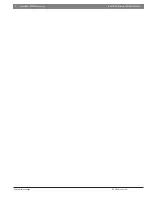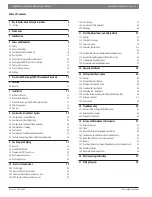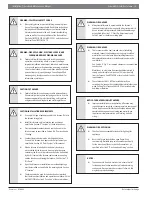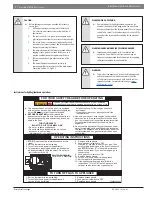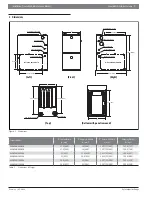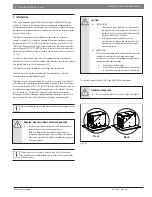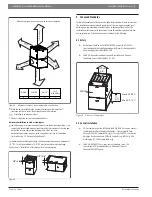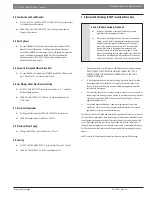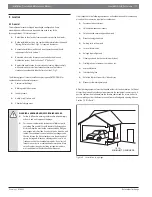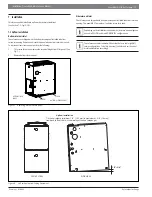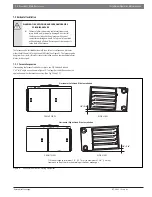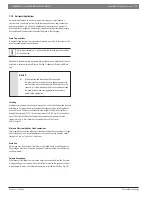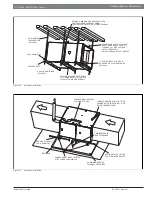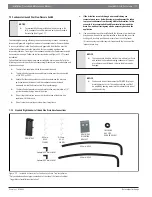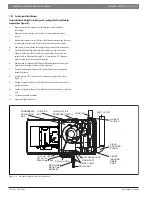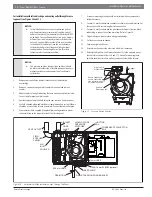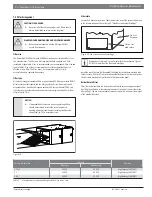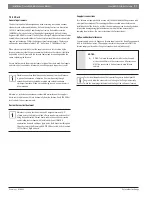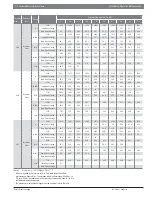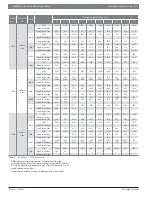
1 0 |
E
coer
96%
A
F
UE
Gas Furnace
Installation, Operation & Maintenance
07-2021
|
E
coer
I
nc
.
Data subject to change
4.3 Combustion and Ventilation Air
US: Section 9.3 of the NFGC, NFPA 54/ANSI Z223.1-latest edition Air
for Combustion and Ventilation
CANADA:Part 8 of CAN/CSA-B149.1-05,Venting Systems and Air
Supply for Appliances.
4.4 Duct Systems
US and CANADA: Air Conditioning Contractors Association (ACCA)
Manual D, Sheet Metal and Air Conditioning Contractors National
Association (SMACNA), or American Society of Heating, Refrigeration,
and Air Conditioning Engineers (ASHRAE) 2001 Fundamentals
Handbook Chapter 34 or 2000 HVAC Systems and Equipment
Handbook Chapters 9 and 16
4.5 Acoustical Lining and Fibrous Glass Duct
US and CANADA: Current edition of SMACNA and NFPA 90B as tested
by UL Standard 181 for Class I Rigid Air Ducts
4.6 Gas Piping and Gas Pipe Pressure Testing
US: NFPA 54/ANSI Z223.1-latest edition Chapters 5,6, 7, and 8 and
National Plumbing Codes
CANADA: CAN/CSA-B149.1-05 Parts 4,5 and 6 and Appendices
A,B,E,and H.
4.7 Electrical Connections
US: National Electrical Code (NEC) ANSI/NFPA 70-latest edition
CANADA: Canadian Electrical Codes CSA C22.1.
4.8 Electrical Power Supply
Voltage: ANSI C84.1- latest edition (104-127 volt)
4.9 Venting
US: NFGC NFPA 54/ANSI Z223.1-latest edition; Chapters 12 and 13
CANADA: CAN/CSA-B149.1-05 Part 8 and Appendix C.
5 Electrostatic Discharge (ESD) Precautions Procedure
NOTICE: FURNACE RELIABILITY HAZARD
Improper installation or service of furnace may cause
premature furnace component failure.
Electrostatic discharge can affect electronic components.
Follow the electrostatic discharge precautions procedure
listed below during furnace installation and servicing to
protect the furnace electronic control. Precautions will
prevent electrostatic discharges from personnel and
hand tools which are held during the procedure. These
precautions will help to avoid exposing the control board to
electrostatic discharge by putting the furnace, the control
board, and the person at the same electrostatic potential.
1.
Disconnect all power to the furnace. Multiple disconnects maybe required.
DO NOT TOUCH THE CONTROL OR ANY WIRE CONNECTED TO THE
CONTROL PRIOR TO DISCHARGING YOUR BODY'S ELECTROSTATIC
CHARGE TO GROUND.
2.
To discharge your body's electrostatic charge to ground,
fi
rmly touch the
clean, unpainted, metal surface of the furnace chassis which is close to
the control board.Tools held in a person's hand during grounding will be
satisfactorily discharged.
3.
After touching the chassis, you may proceed to service the control board or
connecting wires as long as you do nothing to recharge your body with static
electricity (for example; DO NOT move or shuf
fl
e your feet, do not touch
ungrounded objects, etc.).
4.
If you touch ungrounded objects (and recharge your body with static
electricity),
fi
rmly touch a clean, unpainted metal surface of the furnace
again before touching control board or wires.
Use this procedure for installed and uninstalled (ungrounded) furnaces. In the case
of control board replacement, before removing the replacement control board from
its packaging, discharge your body's electrostatic charge to ground to protect the
control from damage. If the control is to be installed in a furnace, follow steps 1
through 4 before bringing the control board or yourself in contact with the furnace.
Put all used and new control boards into containers before touching ungrounded
objects.
An ESD service kit (
fi
eld supplied) may also be used to prevent ESD damage.


